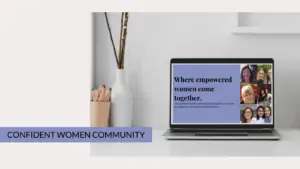#223: Positive Communication in English [At Work and On Teams]

We all know good communication is an essential skill creating and maintaining good relationships with others and, in the workplace, it leads to better outcomes including:
- A stronger team
- Improved collaboration
- Clarity in the workplace
To name a few.
But… what exactly is “good communication?”
This can change from one language and culture to another.
If you’re struggling to make positive first impressions, build rapport, or maintain positive, open channels of communication at work in English, then this lesson is for you.
A few months ago I shared a lesson on Demonstrating Charisma at Work.
If you enjoyed learning about the power of charisma and how to demonstrate it in English, then this lesson is the perfect follow-up.
You’ll gain insight on different ways to communicate with positive language so that you can always choose what is best for you in the moment when you’re speaking and building relationships with others, whether it’s at work or on a team.
4 Strategies & English Phrases for Positive Communication at Work
Technique 1: Use Positive Language
Of course! If we’re talking about positive communication then we want to choose positive language.
For any entrepreneur, business professional, team member or English speaker, positive word choices is a surefire way to show respect and start off on the right foot.
Here are 3 strategies you can rely on for positive language:
- Strategy # 1: Select polite words and phrases to maintain positivity demonstrate your respect for the other person.
- Strategy #2: Similarly, rather than use negative words when offering feedback, opting to embrace negative forms of positive words leaves a positive impression on the listener.
- Imagine a colleague has proposed a new product that simply doesn’t align with the mission. Instead of “that’s not innovative,” you could say: “It’s not as innovative as the products we’re hoping to compete against”.
- “I understand that you’ve worked hard to come up with an innovative solution, but it wasn’t along the lines of our current vision.”
- Strategy #3: Minimize negative connotations through the use of qualifiers. Qualifiers that help to weaken negativity include:
-
- Slightly
- A little
- May/Might
- Kind of
- Could
Technique #2: Be Sincere and Show Interest
The most vital component to positive communication is showing genuine interest and sincerity through the way you communicate.
Beyond using body language and active listening to demonstrate your attention, open-ended questions are a great way to show interest in another person.
To do this effectively…
- Strategy #1: Show interest through open-ended questions. If you would like to learn more about a person’s experience or find a connection you can build on for a stronger relationship, asking an open question is a great way to do that. A few great questions starters include:
- Tell me about a time when you… How/Why…?
- What is your experience with…?
- How was your experience with…?
Technique 3: Use ‘I’ and Validate ‘You’
If you’ve watched several of my lessons on professional English, then you know, ‘I’ statements are powerful tools for stating your thoughts and opinions, particularly when you’re sharing critical feedback or an opposing viewpoint.
On top of that, it’s also a powerful tool for directing the spotlight away from the other person and towards yourself. This is especially useful when you need to set boundaries or provide feedback.
Here are two strategies for embracing this technique:
- Strategy #1: When providing feedback, avoid blaming or increasing the tension of the situation. To do that, you could say:
- I’ve noticed that you’re great at___, but I’d like to help you improve…
- I’m impressed with ___. However, I think we need to work on…
- I think we should prioritize…
- Strategy #2: The same is true when communicating boundaries. You may find the following phrases useful:
- My expectations are… and I think…
- Thank you for ____. However, I don’t feel comfortable with…
- I understand your concerns and agree that ____. That being said, I think…
We’ve all experienced moments when someone’s behavior has made us feel uncomfortable. In these moments, it’s important to clearly communicate a boundary.
For example, if a colleague has taken over a project you could say, “Thank you for taking charge of contacting the clients. However, I don’t feel comfortable doing minimal work. Going forward, I’d like for us to maintain an equal workload.”
Technique #4: Recognize and Show Support
Giving recognition and showing support are clear demonstrators of positive communication. Everyone wants to be appreciated.
It’s also a way for the other person to feel heard and valued.
Here’s how you can do it with sincerity.
- Strategy #1: Compliments are the greatest ways to recognize others and create a positive atmosphere. Here are some excellent sentence starters for professional compliments:
- I appreciate your…
- I’m proud of you/your…
- You did a fantastic job with…
- You truly excelled in…
- Strategy #2: Similarly, showing support is others is a form of recognition and introduces a culture of open and positive communication in the workplace. To show support or encourage someone, you may use empathize and say:
- I understand that this will be difficult/new. However, I’m here to help if you need anything.
- Although the task has some challenges, I believe you have the necessary skills to complete it.
- I understand the initial approach wasn’t successful. Might I suggest…?
Now that you’ve gained insight into how to develop your positive communication in English, I have 2 questions for you:
- Which strategy from today’s lesson did you find the most helpful? Why?
- Describe a time when your word choice or style of communication left a negative impression. In retrospect, what would you have done differently?
I look forward to hearing your responses!
Have a fantastic Confident English Wednesday!
~ Annemarie
P.S. Are you looking for a community to provide support, help you stay motivated, and guarantee that you grow? Check out our Confident Women Community.
Get the Confidence to Say What You Want in English
Follow my 3-step solution to speak English with clarity, fluency, and freedom so you can say what you want with confidence.
You'll also get my Confident English lessons delivered by email every Wednesday and occasional information about available courses. You can unsubscribe any time.
More Like This
How to Ask for and Understand Directions in English
Struggle to ask for directions in English? In this lesson, you’ll learn simple, polite English travel phrases and survival English to ask for help naturally and confidently—even if you’re shy. Get practical English conversation tips, discover what native speakers really say, and build your English communication confidence for your next trip or everyday conversation.
Learn English Phrasal Verbs Faster — 5 Minute Routine
Tired of forgetting English phrasal verbs the moment you need them? In this Confident English lesson, you’ll learn a 5-minute daily routine to make phrasal verbs stick—so you can remember them, use them naturally in real conversations, and finally stop second-guessing. Whether you need phrasal verbs for work, everyday conversations, or English speaking practice, this lesson gives you practical steps that fit your real life.
Sound Fluent & Professional: English Phrases for Meetings & Updates
Want to speak English more naturally at work? In this lesson, you’ll learn powerful English phrases for meetings and updates, including business phrasal verbs professionals use every day. Get the vocabulary and expressions you need to give confident project updates, explain delays clearly, and wrap up your message like a pro.
How to Give a Project Update in English at Work
Give a clear project update in English with a concise 3‑step framework. Get the phrases and structure to deliver professional project status reports confidently at work.
Professional Ways to Ask for Help in English (4-Step Formula)
Learn how to ask for help in English at work—without sounding unsure or unprepared. This 4-step formula gives you clear, professional phrases for meetings, emails, and team collaboration.
30+ English Phrases to Compliment Food Naturally and Politely
Learn 30+ natural English phrases for food and how to compliment food in English politely and sincerely. Perfect for dinner parties, eating out, and everyday English conversations.
© Copyright 2014-2025 Speak Confident English | Privacy Policy | Terms & Disclaimer | Online Class Policies







I have been watching your videos on different strategies to improve communication skills and I would like to congratulate you because they are not only excellent guidelines, but also excellent ideas for business purposes. Thank you very much for your commitment and professionalism.
I’m so pleased to know my lessons have been helpful to you, Abud. Thank you.
How can I improve my listing English skills, and got my special progress. And thank you very much for your efforts.
Thanks for your teaching
This is really good, your English classes are quite good. Thank you for sharing
Thank you so much, Sergio. I’m glad it was helpful.
Very professional, thank you very much Annmarie.
Thank you for your comment, Adriana! We’re happy to hear you enjoyed the lesson!
2) I am back; I can imagine a situation based on my experience in class: Homework well done, but the pupil (P) was helped by another person. On the next day, after checking the pupils’ work, I was surprised by (P)’s results; I invited him to stand up and explain how he has succeeded to do this amazing job, (P)’s face turned red. His mate noticed his embarrassment. Some of them laughed loudly. I continued: I am really impressed by your notable progress(P), I let you explain But the pupil stared at me with teary eyes and said I can’t,… Read more »
HELLO ANNEMARIE,
Thank you for everything!
1)
I would use the strategies 1 and 2 in technique 4.
Obviously, everyone feels pleased when they receive compliments, and hearing sweet words has good effects on human emotion and spreads positive waves,
since they would be receptive to whatever opinion,
however, there could be a kind of disagreement.
So I would try to keep a positive atmosphere, by being tactful, and helpful to the others.
2)
Sorry, I can’ t remember a situation where I could have left a negative impression.
Hi Raoudha, thank you for your comment! We’re excited to hear the lesson was helpful to you! And I love your positive approach of being tactful and helpful to others!